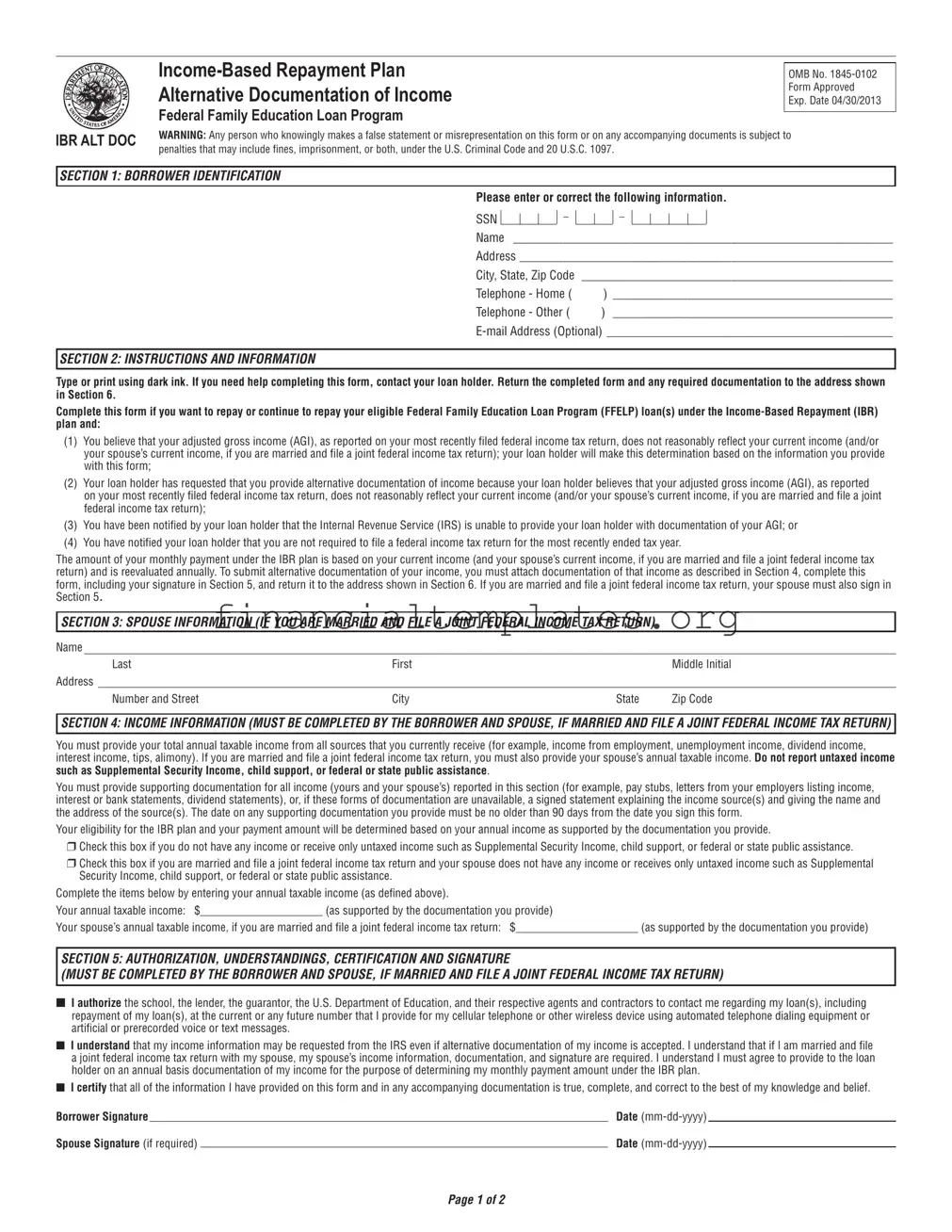IBR ALT DOC |
WARNING: Any person who knowingly makes a false statement or misrepresentation on this form or on any accompanying documents is subject to |
|
|
penalties that may include ines, imprisonment, or both, under the U.S. Criminal Code and 20 U.S.C. 1097. |
|
|
|
|
|
|
|
|
|
|
|
|
|
|
|
|
|
SECTION 1: BORROWER IDENTIFICATION |
|
|
|
|
|
|
|
|
|
|
|
|
|
|
|
|
|
|
|
|
|
|
|
|
|
|
|
|
|
Please enter or correct the following information. |
|
|
|
|
|
|
|
|
|
|
|
|
|
|
|
|
|
|
SSN |
|
|
|
|
|
|
|
|
|
|
|
|
|
|
|
|
|
|
|
|
|
|
|
|
|
|
|
|
|
|
|
|
|
|
Name _____________________________________________________________ |
|
Address ____________________________________________________________ |
|
City, State, Zip Code |
__________________________________________________ |
|
Telephone - Home ( |
) _____________________________________________ |
|
Telephone - Other ( |
) _____________________________________________ |
|
E-mail Address (Optional) ______________________________________________ |
SECTION 2: INSTRUCTIONS AND INFORMATION
Type or print using dark ink. If you need help completing this form, contact your loan holder. Return the completed form and any required documentation to the address shown in Section 6.
Complete this form if you want to repay or continue to repay your eligible Federal Family Education Loan Program (FFELP) loan(s) under the Income-Based Repayment (IBR) plan and:
(1)You believe that your adjusted gross income (AGI), as reported on your most recently iled federal income tax return, does not reasonably relect your current income (and/or your spouse’s current income, if you are married and ile a joint federal income tax return); your loan holder will make this determination based on the information you provide with this form;
(2)Your loan holder has requested that you provide alternative documentation of income because your loan holder believes that your adjusted gross income (AGI), as reported on your most recently iled federal income tax return, does not reasonably relect your current income (and/or your spouse’s current income, if you are married and ile a joint federal income tax return);
(3)You have been notiied by your loan holder that the Internal Revenue Service (IRS) is unable to provide your loan holder with documentation of your AGI; or
(4)You have notiied your loan holder that you are not required to ile a federal income tax return for the most recently ended tax year.
The amount of your monthly payment under the IBR plan is based on your current income (and your spouse’s current income, if you are married and ile a joint federal income tax return) and is reevaluated annually. To submit alternative documentation of your income, you must attach documentation of that income as described in Section 4, complete this form, including your signature in Section 5, and return it to the address shown in Section 6. If you are married and ile a joint federal income tax return, your spouse must also sign in Section 5.
SECTION 3: SPOUSE INFORMATION (IF YOU ARE MARRIED AND FILE A JOINT FEDERAL INCOME TAX RETURN)
Name
|
Last |
First |
|
Middle Initial |
Address |
|
|
|
|
Number and Street |
City |
State |
Zip Code |
SECTION 4: INCOME INFORMATION (MUST BE COMPLETED BY THE BORROWER AND SPOUSE, IF MARRIED AND FILE A JOINT FEDERAL INCOME TAX RETURN)
You must provide your total annual taxable income from all sources that you currently receive (for example, income from employment, unemployment income, dividend income, interest income, tips, alimony). If you are married and ile a joint federal income tax return, you must also provide your spouse’s annual taxable income. Do not report untaxed income such as Supplemental Security Income, child support, or federal or state public assistance.
You must provide supporting documentation for all income (yours and your spouse’s) reported in this section (for example, pay stubs, letters from your employers listing income, interest or bank statements, dividend statements), or, if these forms of documentation are unavailable, a signed statement explaining the income source(s) and giving the name and the address of the source(s). The date on any supporting documentation you provide must be no older than 90 days from the date you sign this form.
Your eligibility for the IBR plan and your payment amount will be determined based on your annual income as supported by the documentation you provide.
r Check this box if you do not have any income or receive only untaxed income such as Supplemental Security Income, child support, or federal or state public assistance.
r Check this box if you are married and ile a joint federal income tax return and your spouse does not have any income or receives only untaxed income such as Supplemental Security Income, child support, or federal or state public assistance.
Complete the items below by entering your annual taxable income (as deined above).
Your annual taxable income: $_____________________ (as supported by the documentation you provide)
Your spouse’s annual taxable income, if you are married and ile a joint federal income tax return: $_____________________ (as supported by the documentation you provide)
SECTION 5: AUTHORIZATION, UNDERSTANDINGS, CERTIFICATION AND SIGNATURE
(MUST BE COMPLETED BY THE BORROWER AND SPOUSE, IF MARRIED AND FILE A JOINT FEDERAL INCOME TAX RETURN)
nI authorize the school, the lender, the guarantor, the U.S. Department of Education, and their respective agents and contractors to contact me regarding my loan(s), including repayment of my loan(s), at the current or any future number that I provide for my cellular telephone or other wireless device using automated telephone dialing equipment or artiicial or prerecorded voice or text messages.
nI understand that my income information may be requested from the IRS even if alternative documentation of my income is accepted. I understand that if I am married and ile a joint federal income tax return with my spouse, my spouse’s income information, documentation, and signature are required. I understand I must agree to provide to the loan holder on an annual basis documentation of my income for the purpose of determining my monthly payment amount under the IBR plan.
nI certify that all of the information I have provided on this form and in any accompanying documentation is true, complete, and correct to the best of my knowledge and belief.
|
|
|
|
Borrower Signature |
|
Date (mm-dd-yyyy) |
Spouse Signature (if required) |
|
Date (mm-dd-yyyy) |


